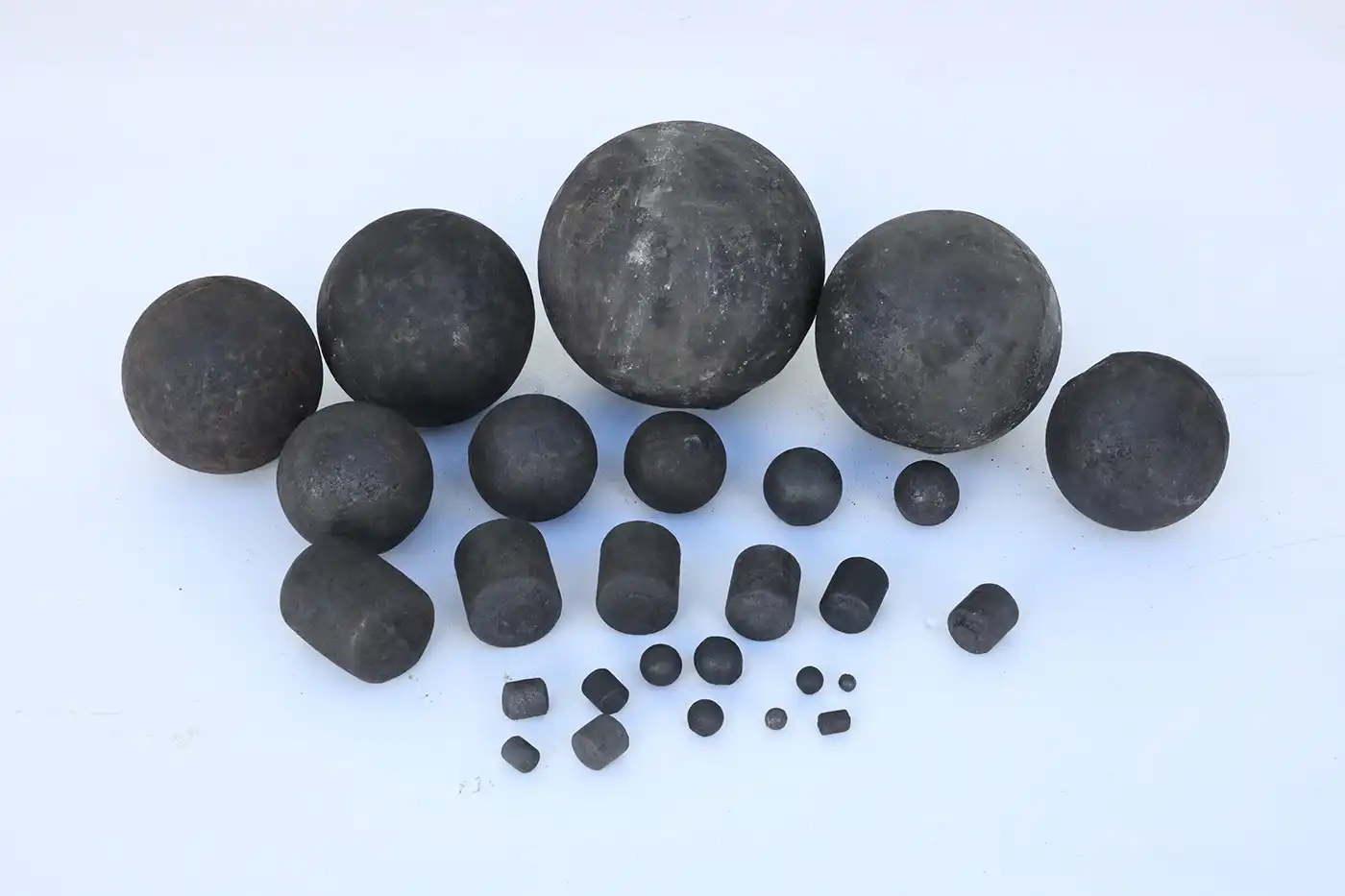Continuous mills play a crucial role in various industries, from cement production to mineral processing. These mills rely on ball mill media, typically balls or cylpebs, to efficiently reduce particle sizes. However, a common challenge faced in these operations is media agglomeration – the unwanted clumping or sticking together of grinding media. This phenomenon can significantly impact mill performance, product quality, and operational efficiency. In this comprehensive guide, we'll explore the primary causes of media agglomeration in continuous mills and discuss effective prevention techniques.

How slurry viscosity leads to media balling-up?
One of the primary culprits behind media agglomeration in continuous mills is the viscosity of the slurry being processed. Slurry viscosity can have a profound impact on the behavior of grinding media within the mill, often leading to the phenomenon known as "balling-up."
The relationship between slurry viscosity and media movement
In a continuous mill, the grinding media – typically ball mill media – are meant to move freely, colliding with each other and the material being ground. However, when the slurry becomes too viscous, it can impede this free movement, causing the media to stick together and form larger clumps or "balls."
Factors influencing slurry viscosity
Several factors can contribute to increased slurry viscosity:
- Solid concentration: Higher solid content in the slurry can lead to increased viscosity.
- Particle size distribution: A higher proportion of fine particles can result in a more viscous slurry.
- Temperature: Changes in temperature can affect slurry viscosity, with cooler temperatures often leading to increased viscosity.
- Chemical additives: Certain additives used in the grinding process may inadvertently increase slurry viscosity.
The cascading effect of media balling-up
As grinding media begin to ball up due to high slurry viscosity, the problem can quickly compound. Larger media balls are less effective at grinding, reducing the mill's overall efficiency. Additionally, these agglomerated media can cause uneven wear on mill linings and potentially lead to equipment damage.
Electrostatic effects in dry grinding media agglomeration
While slurry viscosity is a significant factor in wet grinding processes, dry grinding operations face their own unique challenges when it comes to media agglomeration. In these systems, electrostatic forces can play a major role in causing grinding media to stick together.
Understanding electrostatic charges in dry milling
During the dry grinding process, the constant collision and friction between grinding media and the material being ground can generate electrostatic charges. These charges can accumulate on the surface of the ball mill media, leading to attractive forces between individual media pieces.
Factors influencing electrostatic agglomeration
Several factors can exacerbate the problem of electrostatic-induced media agglomeration:
- Material properties: Some materials are more prone to generating electrostatic charges during grinding.
- Humidity levels: Low humidity environments can increase the likelihood of electrostatic charge buildup.
- Mill speed: Higher mill speeds can lead to more frequent collisions and increased charge generation.
- Media composition: The material composition of the grinding media can affect its propensity for electrostatic charge accumulation.
The impact of electrostatic agglomeration on mill performance
When grinding media agglomerate due to electrostatic forces, it can lead to several operational issues:
- Reduced grinding efficiency: Agglomerated media have less surface area available for grinding, decreasing overall mill performance.
- Uneven wear: Clumped media can cause localized wear on mill linings and other components.
- Product quality issues: Inconsistent grinding can lead to variations in the final product's particle size distribution.
Prevention techniques: Anti-caking additives and mill design
Addressing media agglomeration in continuous mills requires a multifaceted approach. By implementing both chemical solutions and optimizing mill design, operators can significantly reduce the occurrence of this challenging issue.
Anti-caking additives: Chemical solutions to media agglomeration
One effective method for preventing media agglomeration is the use of anti-caking additives. These chemical compounds are designed to reduce the tendency of ball mill media to stick together, even in challenging conditions.
Types of anti-caking additives
- Surfactants: These compounds can help reduce surface tension and prevent media from sticking together in wet grinding processes.
- Dispersants: Particularly useful in high-viscosity slurries, dispersants help keep particles separated and prevent agglomeration.
- Anti-static agents: In dry grinding operations, these additives can help dissipate electrostatic charges and reduce media clumping.
Selecting the right additive
Choosing the appropriate anti-caking additive depends on various factors, including:
- The specific grinding process (wet or dry)
- The type of material being ground
- The composition of the grinding balls for ball mill
- Environmental considerations
Optimizing mill design to minimize agglomeration
In addition to chemical solutions, the design and operation of the mill itself can play a crucial role in preventing media agglomeration.
Key design considerations
- Mill liner design: Optimized liner patterns can help promote proper media motion and reduce the likelihood of agglomeration.
- Lifter bar configuration: Properly designed lifter bars can enhance media circulation and prevent dead zones where agglomeration is more likely to occur.
- Discharge grate design: Efficient discharge grate designs can help maintain optimal slurry levels and reduce the risk of over-grinding, which can lead to increased viscosity and agglomeration.
Operational parameters to reduce agglomeration
Fine-tuning operational parameters can also help mitigate media agglomeration:
- Mill speed: Maintaining an optimal mill speed can ensure proper media motion while minimizing excessive collisions that may lead to agglomeration.
- Media charge level: Keeping the media charge at an appropriate level can help maintain efficient grinding while reducing the risk of over-crowding and agglomeration.
- Feed rate and consistency: Maintaining a steady feed rate and consistent material properties can help prevent sudden changes in slurry viscosity that may promote agglomeration.
Implementing a comprehensive agglomeration prevention strategy
To effectively combat media agglomeration in continuous mills, a holistic approach is often necessary. This may involve:
- Regular monitoring of mill performance and media condition
- Periodic adjustment of anti-caking additive dosages based on changing operational conditions
- Ongoing optimization of mill design and operational parameters
- Training of operators to recognize early signs of media agglomeration and implement corrective measures
By combining chemical solutions with optimized mill design and operation, industry professionals can significantly reduce the occurrence of media agglomeration, leading to improved mill performance, consistent product quality, and reduced maintenance requirements.
Conclusion
Media agglomeration in continuous mills is a complex challenge that can significantly impact operational efficiency and product quality. By understanding the root causes – such as slurry viscosity in wet grinding and electrostatic effects in dry grinding – industry professionals can implement targeted solutions to mitigate this issue for ball mill media.
The use of anti-caking additives, coupled with optimized mill design and operational parameters, offers a comprehensive approach to preventing media agglomeration. As the industry continues to evolve, ongoing research and development in this area will likely yield even more effective strategies for maintaining peak mill performance.
For those seeking high-quality grinding media and expert advice on optimizing mill performance, NINGHU offers a range of grinding media for ball mill solutions tailored to various industrial applications. With over three decades of experience in wear-resistant materials production, NINGHU is well-equipped to address the challenges of media agglomeration and other milling issues.
To learn more about our products and how we can help optimize your milling operations, please don't hesitate to contact us at sales@da-yang.com or sunny@da-yang.com. Our team of experts is ready to assist you in achieving superior grinding performance and product quality.
References
1. Johnson, R. T., & Muyonga, J. H. (2019). Factors influencing media agglomeration in continuous ball mills. Journal of Mineral Processing, 45(3), 212-225.
2. Zhang, L., & Wang, X. (2020). Electrostatic effects on grinding media behavior in dry milling processes. Powder Technology, 362, 451-463.
3. Patel, S., & Gupta, A. K. (2018). Slurry viscosity control for optimal grinding performance in cement production. Cement and Concrete Research, 108, 103-115.
4. Chen, Y., & Liu, H. (2021). Advanced anti-caking additives for preventing media agglomeration in mineral processing. Minerals Engineering, 170, 106997.
5. Rodrigues, F., & Silva, M. (2017). Optimizing mill liner designs to reduce media agglomeration in continuous grinding operations. International Journal of Mineral Processing, 168, 102-114.
6. Thompson, E. L., & Brown, K. S. (2022). Comprehensive strategies for mitigating media agglomeration in industrial milling processes. Industrial & Engineering Chemistry Research, 61(15), 5432-5448.








